MARIANI’S
Virtual
Gourmet
September 18, 2022
NEWSLETTER
IN THIS ISSUE
OUT AND ABOUT IN PARIS
By Geoff Kalish
NEW YORK CORNER
BENJAMIN PRIME
By John Mariani
ANOTHER VERMEER
CHAPTER 37
By John Mariani
NOTES FROM THE WINE CELLAR
By John Mariani
❖❖❖
 beautiful
songs of the great female vocalists of all
time. Go to: WVOX.com.
The episode will also be archived at: almostgolden.
beautiful
songs of the great female vocalists of all
time. Go to: WVOX.com.
The episode will also be archived at: almostgolden.
❖❖❖
OUT AND ABOUT IN PARIS
By Geoff Kalish
In
addition to the great art at the
Orsay, Pompidou Center, Louvre and l’Orangerie,
on a recent visit to Paris we
found two not-to-be-missed exhibits. The Elsa
Schiaparelli fashion presentation
at the Musée
des Arts Décoratifs
(through January 22) near the  Louvre
at 107 Rue de Rivoli (below) not only
shows the
drawings and actual fashion creations of the
haute couture Italian designer but
also provides photos, news clips and other
material reflective of her life-long
friendships with many surrealist artists and
their influence on her eclectic
clothing. And the periodically changing, newly
opened billionaire François
Pinault’s contemporary art collection (1960s to
present, currently including a
mesmerizing light exhibit and fish balloons that
you set afloat) is at The Bourse
de Commerce, a grandiose
building once home to the Grain Exchange.
Louvre
at 107 Rue de Rivoli (below) not only
shows the
drawings and actual fashion creations of the
haute couture Italian designer but
also provides photos, news clips and other
material reflective of her life-long
friendships with many surrealist artists and
their influence on her eclectic
clothing. And the periodically changing, newly
opened billionaire François
Pinault’s contemporary art collection (1960s to
present, currently including a
mesmerizing light exhibit and fish balloons that
you set afloat) is at The Bourse
de Commerce, a grandiose
building once home to the Grain Exchange.
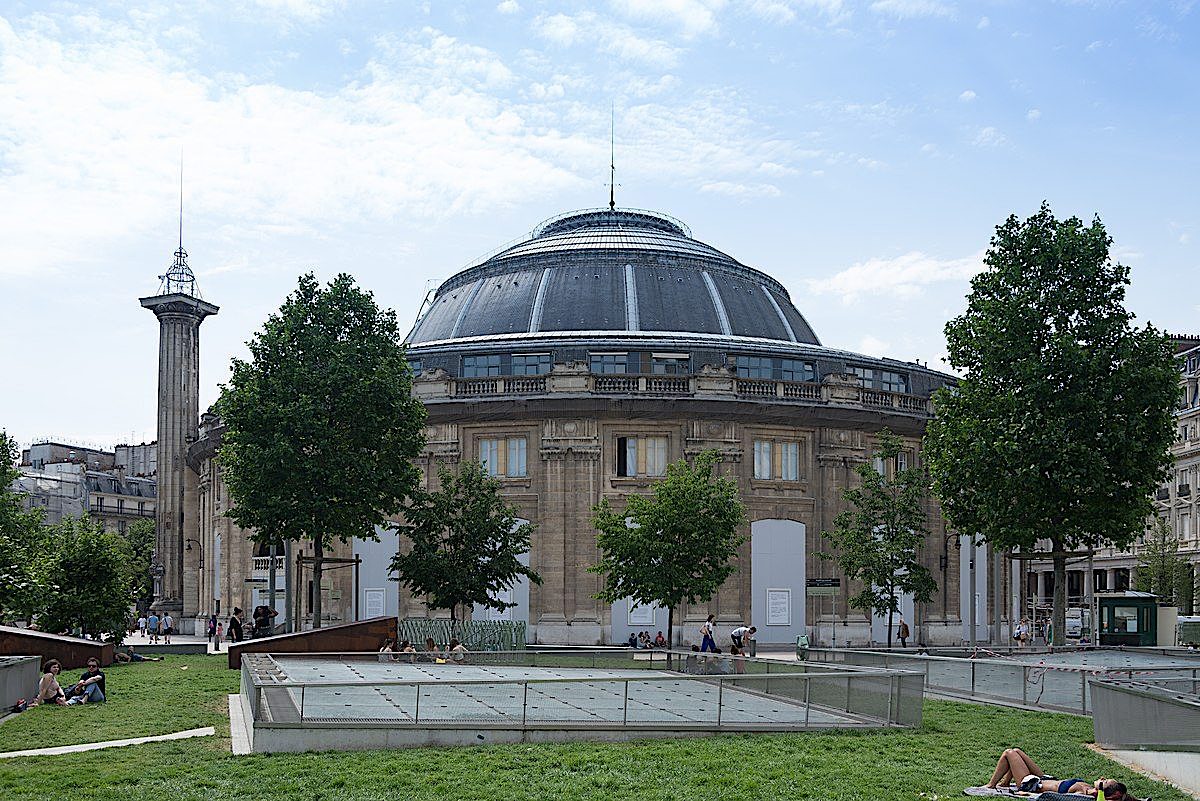
For lodging, we were quite pleased with
our 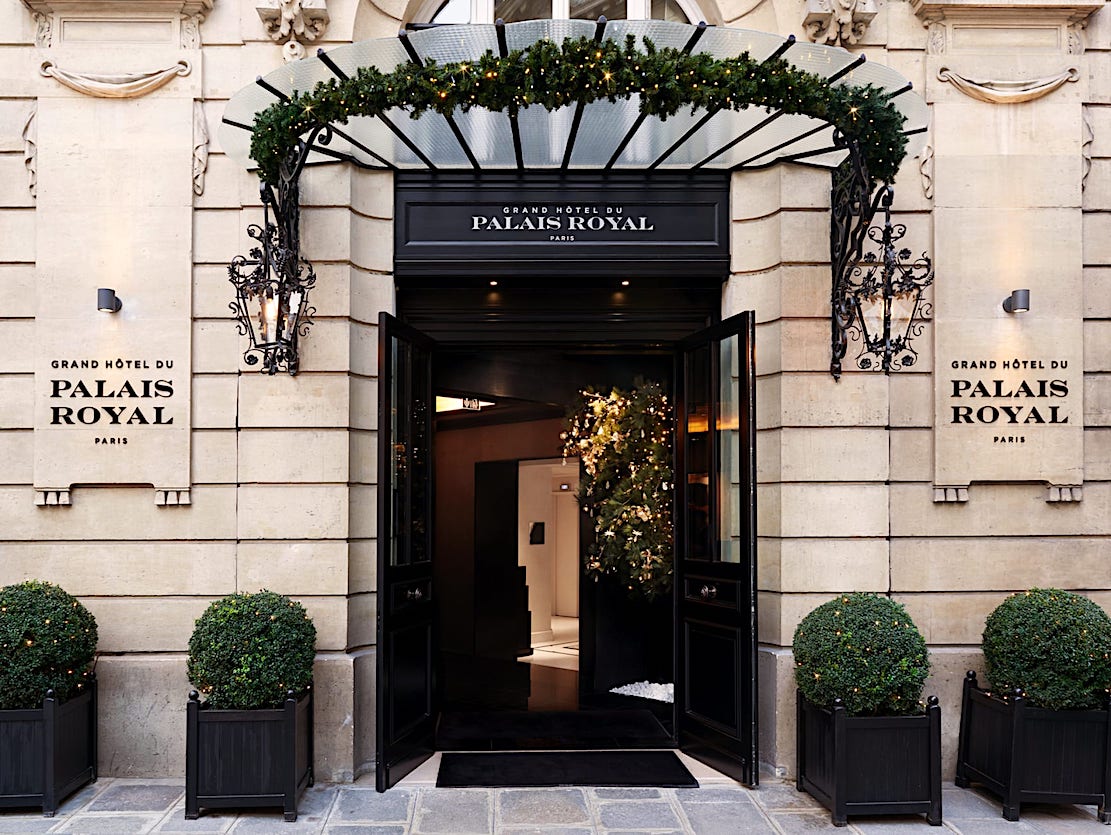 accommodations at the 66-room,
5-star Grand
Hôtel
du Palais du Royal, only a 2-minute walk
from the Louvre. Costing far
less than similar accommodations at other 5-star
Paris hotels, our room was
quite spacious, with a view of the city and an
elegant, modern bathroom with a
walk-in shower. (It also is opposite the location
of the office used in the
“Emily Visits Paris TV series.) Seating at a more
than adequate buffet
breakfast is available on the backyard patio as
well as in Café 52, where lunch
and dinner focusing on spa-style fare is
available. Also, the concierge
service, with helpful hints on directions,
sightseeing stops and eating
establishments was excellent.
accommodations at the 66-room,
5-star Grand
Hôtel
du Palais du Royal, only a 2-minute walk
from the Louvre. Costing far
less than similar accommodations at other 5-star
Paris hotels, our room was
quite spacious, with a view of the city and an
elegant, modern bathroom with a
walk-in shower. (It also is opposite the location
of the office used in the
“Emily Visits Paris TV series.) Seating at a more
than adequate buffet
breakfast is available on the backyard patio as
well as in Café 52, where lunch
and dinner focusing on spa-style fare is
available. Also, the concierge
service, with helpful hints on directions,
sightseeing stops and eating
establishments was excellent.
As to dining, while Paris boasts over 100
Michelin-starred restaurants (including 10 with
the top 3-star rating), having
visited a number of these establishments in the
past, in general we found many
of them too artsy in their food presentation and
way too expensive—some costing
almost $1,000 for two, not even including wine
(generally at quite inflated
prices). So,
instead we “bistro-ed it,”
with our top experiences discussed below. Also,
while Paris was teeming with
tourists, these were establishments primarily
frequented by “locals.”
Café de L'Époque
2
Rue du Bouldi
Located a few
minutes walk from our
hotel, this unassuming establishment with a
turn-of-the-century style interior
and a large outdoor terrace offers a wide choice
of top-flight French
bistro-style fare, with friendly, professional
service and a short but above
average selection of wine.
For starters we chose a slice of dense
yet moist duck terrine served with crusty grilled
bread, heady mustard and cornichons
as well as a salad of broiled
shrimp and avocado set atop fresh, crisp greens.
Our main courses consisted of
a large whole sea bass broiled to perfection and
served with green beans and a
medium-rare charcoal-broiled ribeye steak
accompanied by greaseless French
fries.
Desserts were a classic homemade tarte
Tatin topped with a large dollop of crème fraiche
and an apple sorbet doused
with calvados.
We accompanied the
meal with a 2017 Frédric Mangien Gévrey-Chambertin
Vielles Vignes that showed a
fragrant bouquet and soft, but ripe flavors of
plums and cranberries with a
long-lasting finish. (The cost for dinner for two
was $225, including wine, tax
and service.)
Les Fines Gueules
43 Rue Croix des Petits Champs
Recommended by our hotel concierge, this
“wine bar” (also walking distance from our hotel)
was situated inside and on
the adjacent sidewalk of a corner building dating
from the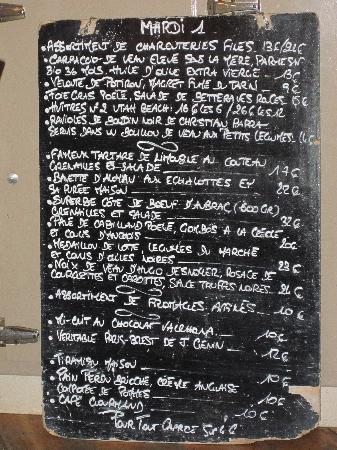 17th century.
Dinner, with a wide range of choices from a
daily-changing blackboard menu, was
served on apricot-hued cloths by knowledgeable,
helpful professionals.
17th century.
Dinner, with a wide range of choices from a
daily-changing blackboard menu, was
served on apricot-hued cloths by knowledgeable,
helpful professionals.
We chose a large steamed artichoke
stuffed with a crunchy
combination of blanched haricots verts, crisp
salad
greens and a mix of nuts doused in a light
vinaigrette, as well as a bowl of
barely grilled tuna atop chunks of grilled
eggplant coated with a heady sauce
containing orange fish roe. Our main courses
consisted of a grilled filet of
sea perch atop an assortment of seared vegetables
and a dish of different cuts
of grilled lamb on a bed of diced artichoke hearts
and couscous with a sauce of
lamb juice and herbs.
For dessert we enjoyed a lemon tart
served with thin slabs of meringue and strewn with
a fine dice of fruit and
nuts, and an order of sweet
apricot
Tartin. We accompanied the meal with a bottle of
raspberry-scented 2019 Morgan,
served slightly chilled. (The meal, including tax,
service and wine, cost
$170.)
 24
Le Restaurant
24
Le Restaurant
24
Rue Jean Mermoz
Sequestered
on a quiet street, a short
walk from the Place de la Concorde, this bistro
serves fare that’s every bit as
good as a Michelin-starred restaurant, and in
fact better than some. And, while
seating is in a narrow room with dark wood
walls, it is most pleasurable to sit
on the tented terrace in front of the
establishment. Service, China and wine
glasses are first class.
We started with a preparation of thin
slices of just-ripe avocado topped with kernels
of fresh corn, cuts of red
onion and radish, all studded with
truffle-flavored popcorn, and a
salad of crunchy, slightly cooked green
beans, mixed with slivers of almonds dressed
with good olive oil and
accompanied by quarter of a hard-boiled egg and
two slices of a sweet
nectarine. 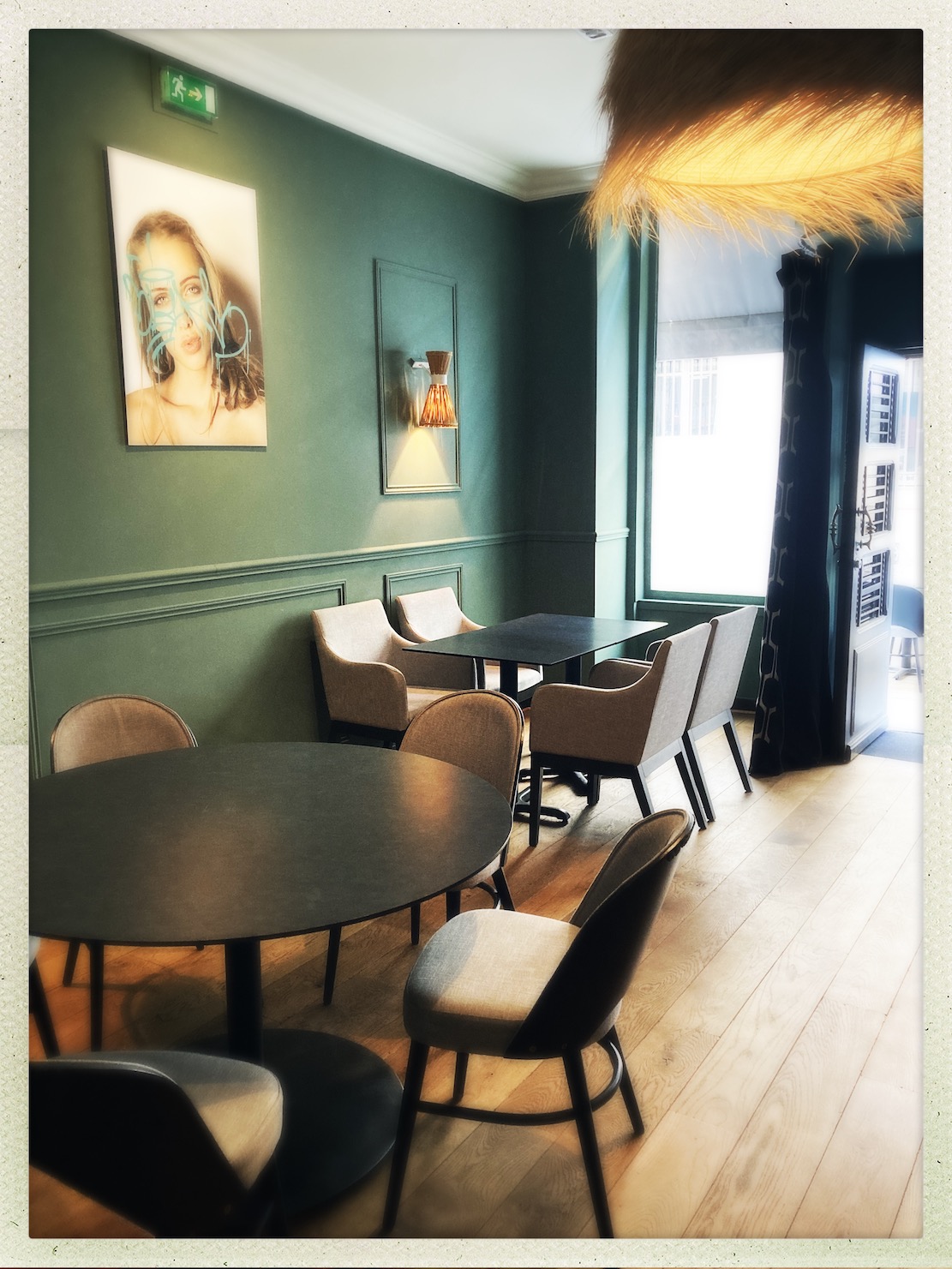
Main courses consisted of a thick slice
of grilled fillet of Normandy Pollock served
with slices of cooked zucchini set
atop a foam of seafood and spices. Slices of a
medallion of medium-rare veal,
served with a grilled baby eggplant and a
mousseline of carrots, were all
doused with a tangy emulsion of ginger and
Indian spices. For dessert we
selected a plate composed of a raspberry
macaroon accompanied by raspberry
sorbet and a white chocolate ganache, with
bourbon-vanilla ice cream and a
slice of peach doused with a sweet apricot
sauce.
We accompanied the meal with a bottle of
2019 Domaine Maillard Père & Fils
Savigny-Les-Bains that had a floral
bouquet and delicate taste of ripe cherries and
raspberries and a smooth
finish, with hints of wild herbs that mated
perfectly with both the fish and
veal. (The dinner for two was an
amazing
$185, including wine, tax and service.)
 And for a falafel fix, head to
the Marais
area and wait in line at L’As du
Falafel (34 Rue de
Rossiers) for
a pita stuffed with fried balls of falafel (ground
chickpeas and spices),
tahini dressing plus an accompaniment like grilled
eggplant piled on top. If
the inside is crowded, take your food out and head
down the street to the park
and grab a bench. ($8 for the basic falafel.)
And for a falafel fix, head to
the Marais
area and wait in line at L’As du
Falafel (34 Rue de
Rossiers) for
a pita stuffed with fried balls of falafel (ground
chickpeas and spices),
tahini dressing plus an accompaniment like grilled
eggplant piled on top. If
the inside is crowded, take your food out and head
down the street to the park
and grab a bench. ($8 for the basic falafel.)
❖❖❖
BENJAMIN PRIME
212-338-0818
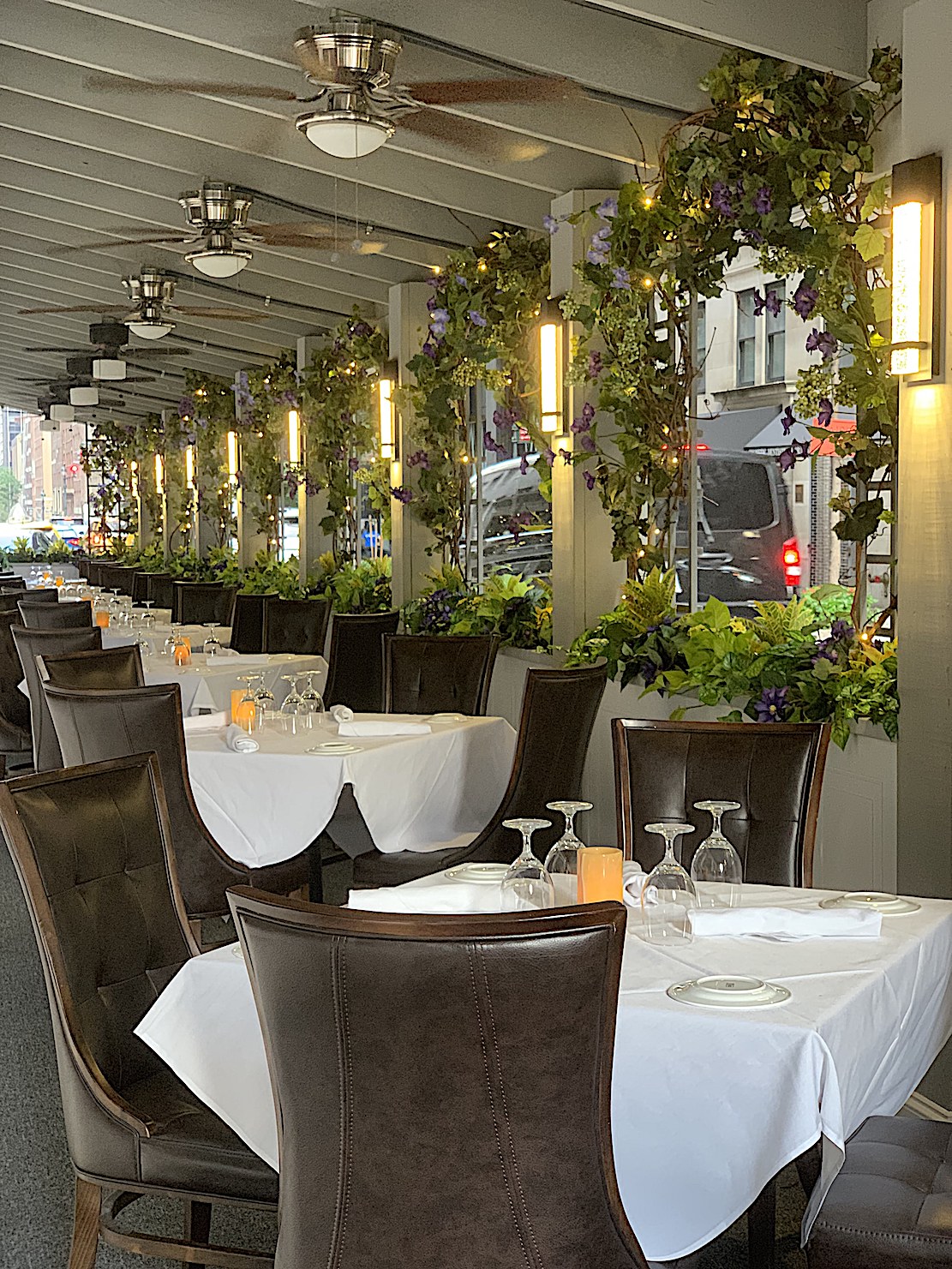
By John Mariani
Summer
was trying to hold last week when
I visited Benjamin Prime on Manhattan’s East
Side, whose office buildings are
again filling up and whose occupiers are hungry
for a great steak dinner. Just
past twilight the temperature was in the low
70s, making it a capital idea to
dine al fresco within a beautifully designed,
well-lighted tent space trimmed
in greenery with a pleasing view of passersby.
The moon was in its three-quarters phase,
and New York seemed at peace
again after the distress of the pandemic. (I’m
told the outdoor section,
enclosed, will
remain open through
winter.)
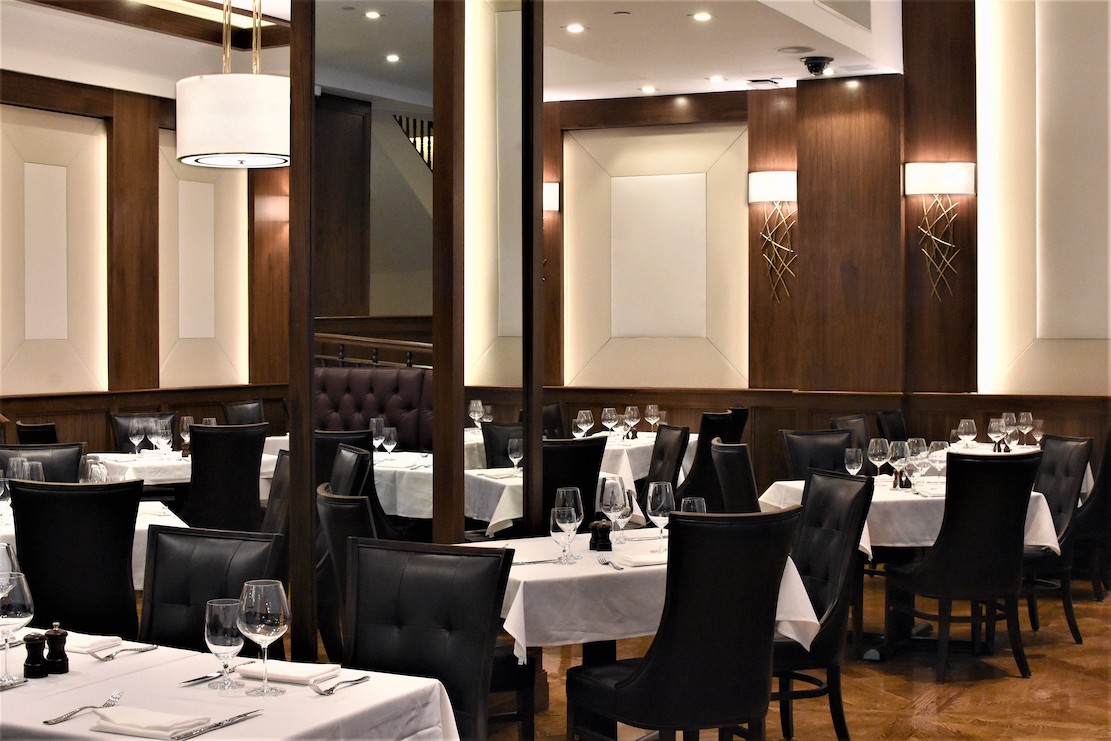 There
is, perhaps, no better place to
celebrate New York’s enduring vitality than at a
classic sophisticated
steakhouse, and the family-owned Benjamin
Restaurant Group, whose first unit
opened in 2006, has grown to several others in New
York and as far as Tokyo and
Kyoto. They also run the Sea Fire Grill reviewed
here a few months ago.
Benjamin Prime opened in 2016.
There
is, perhaps, no better place to
celebrate New York’s enduring vitality than at a
classic sophisticated
steakhouse, and the family-owned Benjamin
Restaurant Group, whose first unit
opened in 2006, has grown to several others in New
York and as far as Tokyo and
Kyoto. They also run the Sea Fire Grill reviewed
here a few months ago.
Benjamin Prime opened in 2016.
Owners Benjamin Prelvukaj and Benjamin
Sinanaj and their staff have a very personal touch
with all their clientele,
which includes a great number of regulars,
newcomers and a large component of
Asian tourists. It is a mark of those Eastern
Europeans, in this case Albanian,
to hire veterans from within who share the same
sense of cordiality. No guest
waits long for a waiter to appear or for the food
to come out of the kitchen.
Benjamin Prime inside takes over 10,000
square feet with a high ceiling—it can get loud at
peak hours, which end around
nine—done in dark woods, leather banquettes,
sprays of flowers and spacious
tables set with white linens. Upstairs are five
private party rooms seating
150.
I don’t discern much difference from
Benjamin Prime (hereafter BP) and the other
Benjamins, since they all .jpg) serve
USDA
Prime beef, as well as Colorado lamb. Some of the
dishes may slightly
differ, but overall they share the same menu, all
steakhouse classics of a kind
that never go out of style.
serve
USDA
Prime beef, as well as Colorado lamb. Some of the
dishes may slightly
differ, but overall they share the same menu, all
steakhouse classics of a kind
that never go out of style.
This is the kind of menu that begs the
question, “What am I in the mood for?” You
probably came for the beef, which
we’ll get to in a moment, but let’s begin at the
beginning with a selection of
tartares—Scottish salmon and yellowfin tuna with a
citrus crème fraîche ($27);
filet mignon with black truffle crème fraîche and
truffle shavings ($35); or
strip loin and foie gras with caramelized onions
($39), all of which are out of
the ordinary compared with other steakhouses’.
Lobster bisque ($19) rises or
falls on how much lobster flavor the soup has and
how much lobster meat is
included, criteria BP meets generously.
 There
is a dish of two lump crabmeat
cakes ($29) as an appetizer that would usually be
offered as a more expensive
main course. These are meaty, creamy and come with
a red pepper coulis, beet
remoulade, frisée lettuce and tartar sauce. As
elsewhere, there is sizzling
Canadian bacon “extra thick” ($29) and it’s true.
Juicy and full flavored (right), this
can easily be shared at a table for two or more
because each morsel is so rich.
There
is a dish of two lump crabmeat
cakes ($29) as an appetizer that would usually be
offered as a more expensive
main course. These are meaty, creamy and come with
a red pepper coulis, beet
remoulade, frisée lettuce and tartar sauce. As
elsewhere, there is sizzling
Canadian bacon “extra thick” ($29) and it’s true.
Juicy and full flavored (right), this
can easily be shared at a table for two or more
because each morsel is so rich.
BP dry ages its beef in its own cold
lockers, and the 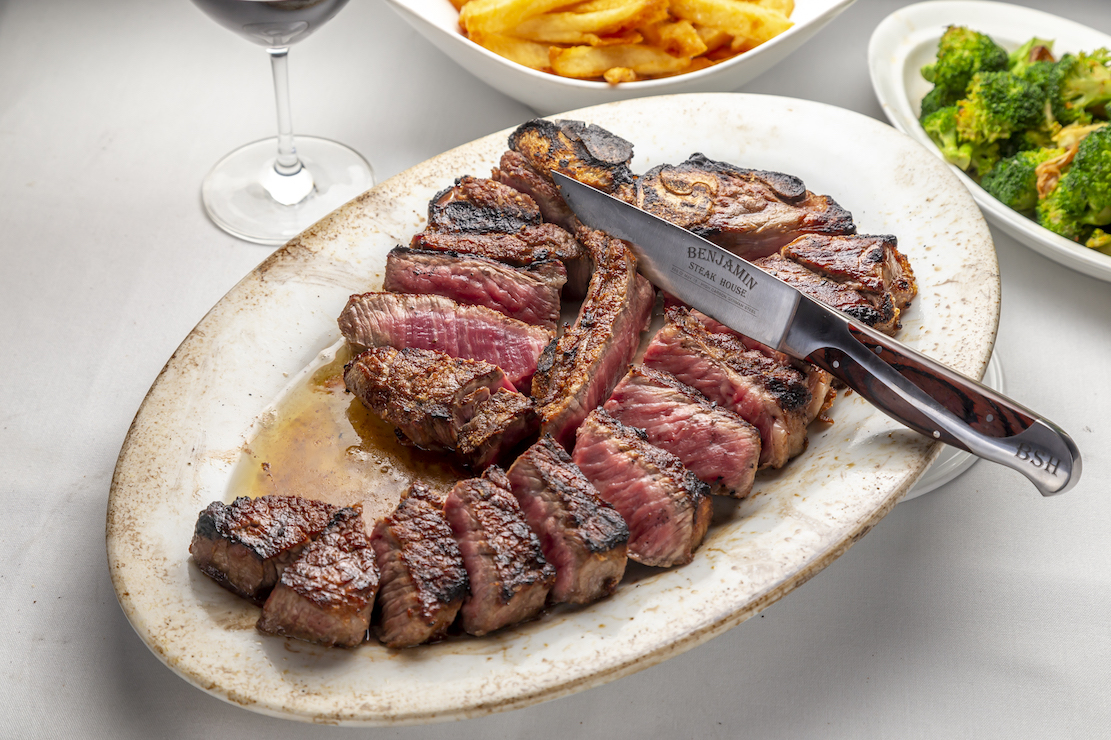 porterhouse
cut that has become a New York signature can be
had for two, three or four people ($132 for two,
$198 for three, $264 for four),
and believe me, any of that number will end up
taking some home. The option for
two people will readily feed three and three four.
The beef takes a good char
and remains succulent throughout, suffused with
melting marbleized fat. The
rack of lamb from Colorado is expertly cooked as
well and comes with
old-fashioned mint jelly ($65).
porterhouse
cut that has become a New York signature can be
had for two, three or four people ($132 for two,
$198 for three, $264 for four),
and believe me, any of that number will end up
taking some home. The option for
two people will readily feed three and three four.
The beef takes a good char
and remains succulent throughout, suffused with
melting marbleized fat. The
rack of lamb from Colorado is expertly cooked as
well and comes with
old-fashioned mint jelly ($65).
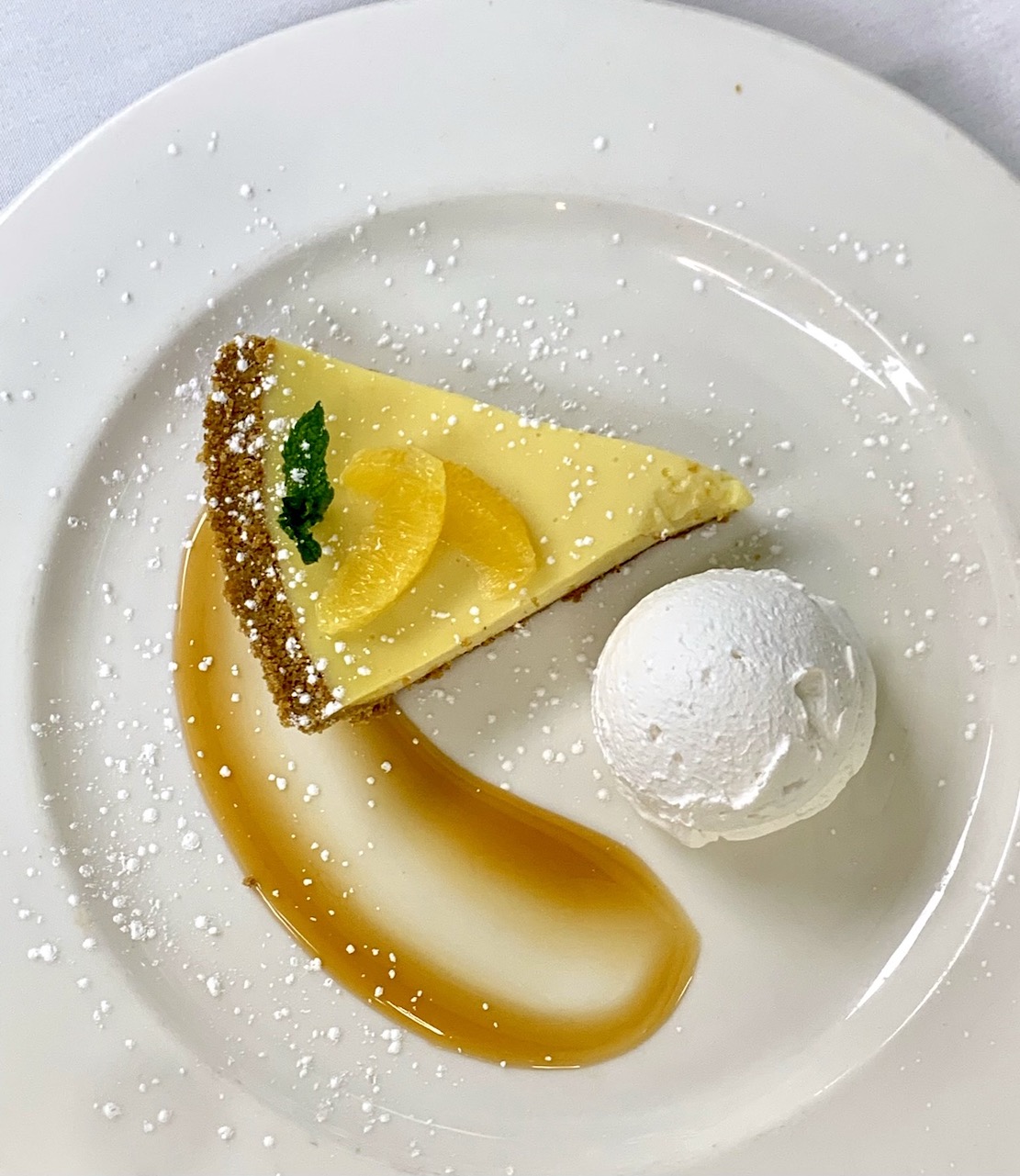 The swordfish
($45) comes from off
Montauk, Long Island, and it’s sweet and meaty,
with a light blacken seasoning
and creamy tartar sauce. The home-fried potatoes
($16) are about average, the
“creamless” creamed spinach ($16) delicious and
the onion rings ($17) addictive
and come in a lavish portion.
The swordfish
($45) comes from off
Montauk, Long Island, and it’s sweet and meaty,
with a light blacken seasoning
and creamy tartar sauce. The home-fried potatoes
($16) are about average, the
“creamless” creamed spinach ($16) delicious and
the onion rings ($17) addictive
and come in a lavish portion.
The best of several excellent house-made
desserts ($14) is the Key lime pie with just the
perfect balance of tang, sweetness
and velvety texture throughout.
BP’s wine list, as at all the company’s
units, is outstanding, and it gets a clientele
willing to pop for the big
Bordeaux, Barolos and California Cabs. Prices,
expectedly, are not cheap but
tell your budget to the manager and he’ll meet it
with the best of breed.
It is that overall, all-around
hospitality that distinguishes BP. Its space is
big and convivial, the
atmosphere lively and the option of dining
outdoors through winter gives an
added reason for choosing this among so many East
Side beef emporiums.
Open
for lunch and dinner
Monday-Friday; dinner Saturday and Sunday.
ANOTHER VERMEER

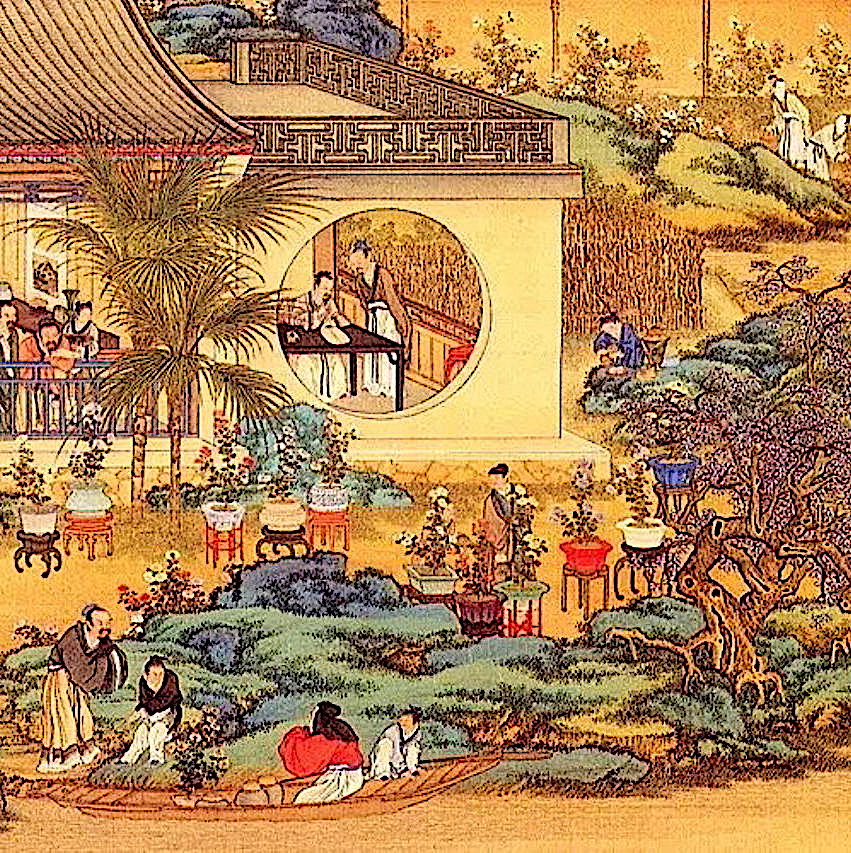
The
flight to Taipei on China Airlines
was going to be close to 17 hours, leaving at
the ungodly hour of 12:20 a.m.,
which Katie thought was just fine because she
had no trouble sleeping on a
plane, even though they were arriving a whole
day later at 5:30 in the morning
Taiwan time. David never slept well on an
airplane, except when he and Katie
flew together to Italy on the Capone case and
she fell asleep on his shoulder.
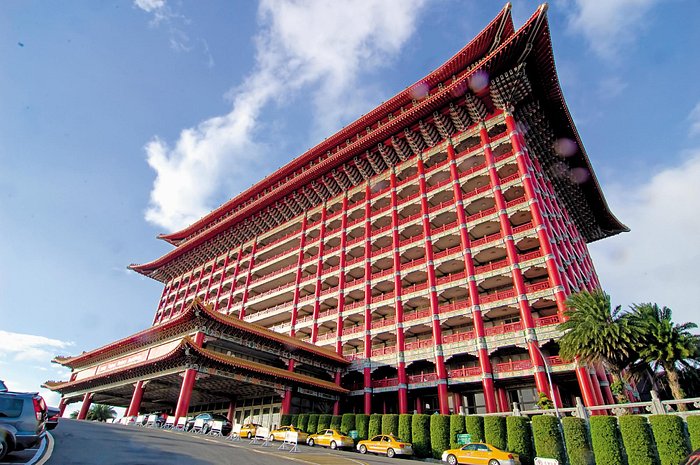 Katie
had booked rooms at Taipei’s most famous hotel,
appropriately called the Grand, set majestically
on the ruins of a former
Shinto shrine at the top of a hill surrounded by
a park. The Grand was opened
in 1952 by Chiang Kai-Shek, who wanted a
five-star hotel to attract foreign
ambassadors—Presidents Richard Nixon, Ronald
Reagan and Bill Clinton had all
stayed there—and put his wife, Soong May, in
charge of the pagoda-like project,
which was expanded over the years and decorated
with so many dragon motifs in
red and gold that it earned the nickname Dragon
Palace.
Katie
had booked rooms at Taipei’s most famous hotel,
appropriately called the Grand, set majestically
on the ruins of a former
Shinto shrine at the top of a hill surrounded by
a park. The Grand was opened
in 1952 by Chiang Kai-Shek, who wanted a
five-star hotel to attract foreign
ambassadors—Presidents Richard Nixon, Ronald
Reagan and Bill Clinton had all
stayed there—and put his wife, Soong May, in
charge of the pagoda-like project,
which was expanded over the years and decorated
with so many dragon motifs in
red and gold that it earned the nickname Dragon
Palace.
On arrival at the Grand, Katie and David
were impressed
by the immense size of the lobby, with massive
red columns and gold inlaid
ceiling.
“I have two rooms booked, under the names
Cavuto and
Greco,” Katie told the check-in attendant,
handing him their passports and her
corporate credit card.
“Ah, yes, welcome to the Grand,” said the
man, “but we
will not need your credit card. Everything has
been taken care of by Mr. Hai
Shui. He has booked you in two of our very
finest rooms, connected, on the top
floor. I’m sure you’ll be very happy with them.”
Katie and David looked at each other,
then she told the
attendant, “That’s very kind of Mr. Shui, but
I’m afraid I’m not able to accept
his largess. You see, I am a journalist here to
interview Mr. Shui, and I have
to pay my own expenses. It’s a rule of my
magazine.”
The man seemed truly stunned, even
embarrassed, not quite sure what to say or do,
so he apologized and excused
himself for a moment to speak with his manager,
who came from his office to
greet the two Americans. He was impeccably
tailored in a double-breasted, dark
blue suit of shantung silk, white shirt and gold
tie.
“Permit me to introduce myself,” he said
with a big smile
and a small bow.
“I am Mr. Chou, the
hotel general manager, and we’ve been expecting
you, Ms. Cavuto, Mr. Greco.
Welcome, welcome to our little Dragon Palace.”
Niceties exchanged, Mr. Chou said, “I
understand that
your magazine does not allow you to be comped
for a room. I completely
understand. Permit me, personally, at least to
upgrade you to rooms on the same
floor at no extra cost. It would be my great
pleasure.”
Katie and David thanked him and said he
was being very
gracious, then she slid her credit card back to
the attendant, who had already
returned their passports and had their luggage
taken away.
“May I invite you to a tea service?”
asked Mr. Chou. “You
must be jetlagged.” Katie
and David
accepted the offer and were led into a quiet
V.I.P. lounge where they settled
back on sumptuous couches and enjoyed a
beautiful service of tea and Chinese
snacks.
“That was a nice gesture on Shui’s part
to want to give
us a free room,” said David.
“Stroking is what it is. He was probably
going to throw a
banquet dinner for us, too. From what I
understand such a thing is always
preliminary to any business discussions, or in
our case an interview.”
“Sounds familiar. The mob capos were
always inviting cops
to restaurants, offering them sports tickets,
weekends with the wife at the
Waldorf.”
“And some cops took them up on the
offers?”
“Not me, but yeah, some did. They
justified it as a way
to get closer to the capos, see how they
operated, pick up some info. But it
was all really just bribery.”
“Did it work?”
“The cops could never be seen with the
capos themselves
but sometimes might have dinner or go to a
Knicks game with the lower wiseguys,
and after a few drinks, the cops picked up some
leads, usually things the
crooks wanted
leaked to the NYPD
about rival mobsters. And
sometimes the
cop might get a little too loose and tip the mob
guys off to something. But the
tip was more of an intentional leak NYPD wanted
spread around. It was all
cat-and-mouse stuff that rarely led to much.”
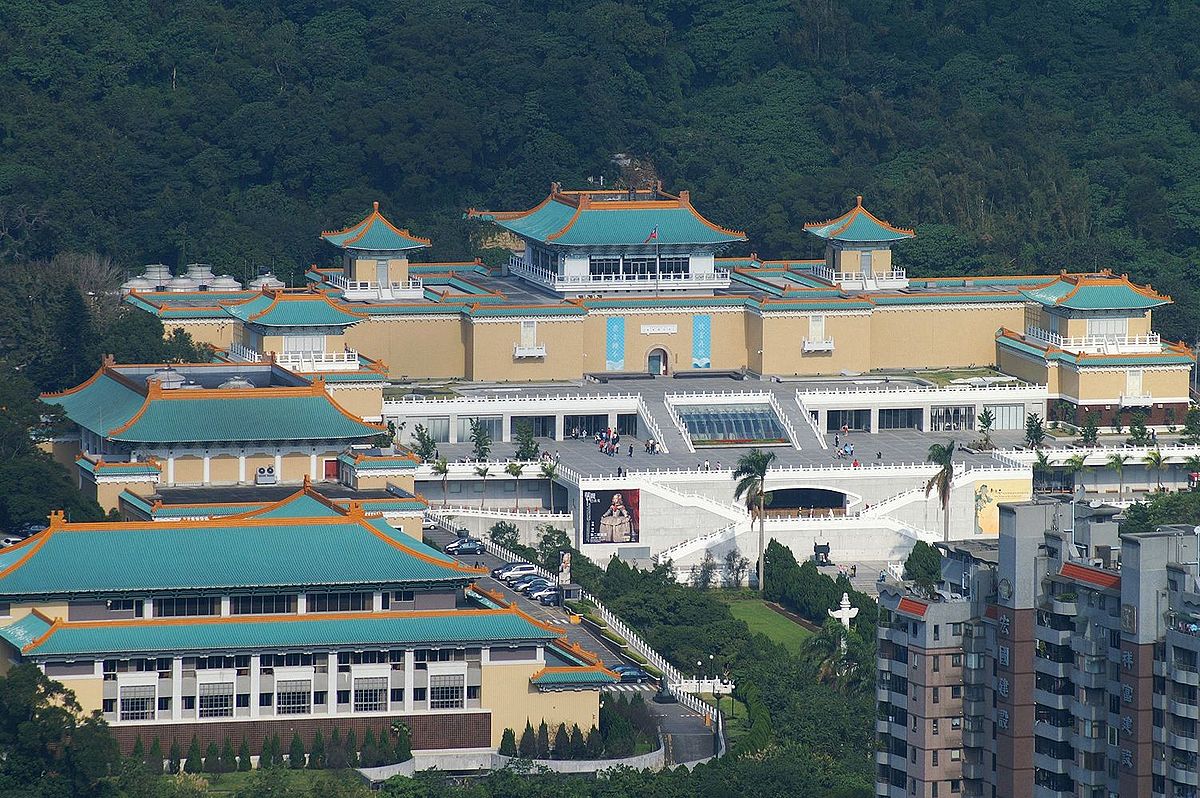 “So, we have a ten o’clock appointment
with Shui
tomorow,” said Katie. “How about we explore
Taipei a little before then?”
“So, we have a ten o’clock appointment
with Shui
tomorow,” said Katie. “How about we explore
Taipei a little before then?”
“Suits me. How’s your Chinese?”
“I can say
‘thank
you’ in five languages, including Chinese.”
“That’ll get us far.”
The two of them set off, having only 24
hours to see the
vast, modern city, so they chose the top sights
and scheduled dinner. They
headed first for the city's proudest cultural
monument, the beautiful National
Palace museum (left), which houses more
than half a million pieces of art and
artifacts, not least an extraordinary collection
of calligraphic scrolls stored
within exquisitely crafted wooden boxes, with
holdings dating back 8,000 years
up through the Qing Dynasty.
Upon arrival at the museum, Katie and
David hired a
private guide named Mr. Wu to give them some
background and to show them the
finest items in the collection.
“The story actually begins in 1925, after
the expulsion
of the last emperor of China,” said Mr. Wu,
“when the Palace Museum opened in
Beijing. But the Civil War caused many items to
be shipped to different parts
of the country, and when General Chiang Kai-Shek
arrived in Taiwan in 1948 he
managed to have an enormous amount brought
here—2,972 crates worth, along with
most of China’s gold reserves. There was much
more left behind on the
mainland—close to two  million
pieces—but Taiwan got, how do say, the cream of
the crop? Ever
since, the People’s
Republic has insisted our collection is
rightfully theirs, and so it goes.
We’ve expanded several times since originally
opening in 1965.”
million
pieces—but Taiwan got, how do say, the cream of
the crop? Ever
since, the People’s
Republic has insisted our collection is
rightfully theirs, and so it goes.
We’ve expanded several times since originally
opening in 1965.”
Mr. Wu went on to show Katie and David an
astounding
array of treasures, including the rarest of
ceramics, bronzes and jade, along
with gorgeous paintings dating back to the
seventh century and the Tang
Dynasty.
Katie was in heaven as they moved from
gallery to
gallery, and David was duly impressed, but felt
increasingly jetlagged.
“Does the museum get a lot of donations?”
he asked.
“Oh, yes, the wealthy people of Taiwan
have been very
generous, both lending and donating major works
to us.”
“Do you know of the billionaire here
named Hai Shui?”
“Oh, yes, everyone knows about Mr. Shui.
He is one of the
richest men in Taiwan.”
“Has he ever lent or donated any of his
collection to the
museum?”
Mr. Wu paused for a moment, then said,
“Of course, we
would be honored to have art from such an
extraordinary collection, but as yet,
Mr. Shui has not been kind enough to lend or
donate any of his art. We can
always hope, however.”
 The tour over and with
the afternoon retreating, Katie
asked Mr. Wu if she should try to visit the
Chiang Kai-Shek Memorial Hall (left), a
monumental
building of monomaniacal scale, entered through
a huge white Gate of Great
Centrality and Perfect Uprightness and flanked by the
National Theater and National Concert Hall.
The tour over and with
the afternoon retreating, Katie
asked Mr. Wu if she should try to visit the
Chiang Kai-Shek Memorial Hall (left), a
monumental
building of monomaniacal scale, entered through
a huge white Gate of Great
Centrality and Perfect Uprightness and flanked by the
National Theater and National Concert Hall.
Mr. Wu said, “I suppose it is worth
seeing if you have
the time, but frankly there’s nothing much to
see inside, just some rooms
devoted to Chiang Kai-Shek and Chinese
Nationalist history.”
“O.K.,” said David, “I say we skip that
one. Besides, I’m
starving. Can
you recommend a good
restaurant around here?”
Mr. Wu turned up his palms and said, “Oh,
there are
thousands, Mr. Greco. Many thousands. It depends
on what you like. But, if you
like seafood, I highly recommend Shin Tung Nan.
They have their own market
stalls right outside the restaurant, so you know
the food is extremely
fresh. Or,
you could visit the Night
Market on Ningxia Road, which has dozens and
dozens of little stalls selling
every kind of food.”
“Shing Tung Nan sounds good for lunch,”
said Katie. “That
okay with you, David?”
“Sure. I hope it’s close by. I’m going to
faint if I
don’t eat soon.
This jetlag has really
kicked in.”
© John Mariani, 2016
❖❖❖
AFTER YEARS OF RUSSIAN
NEGLECT, GEORGIA’S WINE INDUSTRY
HAS
EMERGED
ON THE GLOBAL MARKET

By John Mariani
During
the Soviet occupation of Georgia, the communists
forced its
growers to produce
quantity
rather than quality, and even under
Gorbachev’s more paternalistic anti-alcohol
directives, he cut the quantity but
also the amounts exported to Russia. Since the
mid-1990s, however, Georgia,
with an 8,000 year-old history of viniculture, has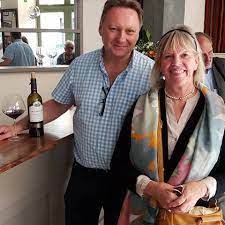 increased its regional and
international profile, now with 525 grape
varieties grown on 55,000 hectares
under cultivation and 1,100 wine companies
licensed to sell commercially, with
93.4 million bottles exported to 53 countries for
sales of $238 million.
increased its regional and
international profile, now with 525 grape
varieties grown on 55,000 hectares
under cultivation and 1,100 wine companies
licensed to sell commercially, with
93.4 million bottles exported to 53 countries for
sales of $238 million.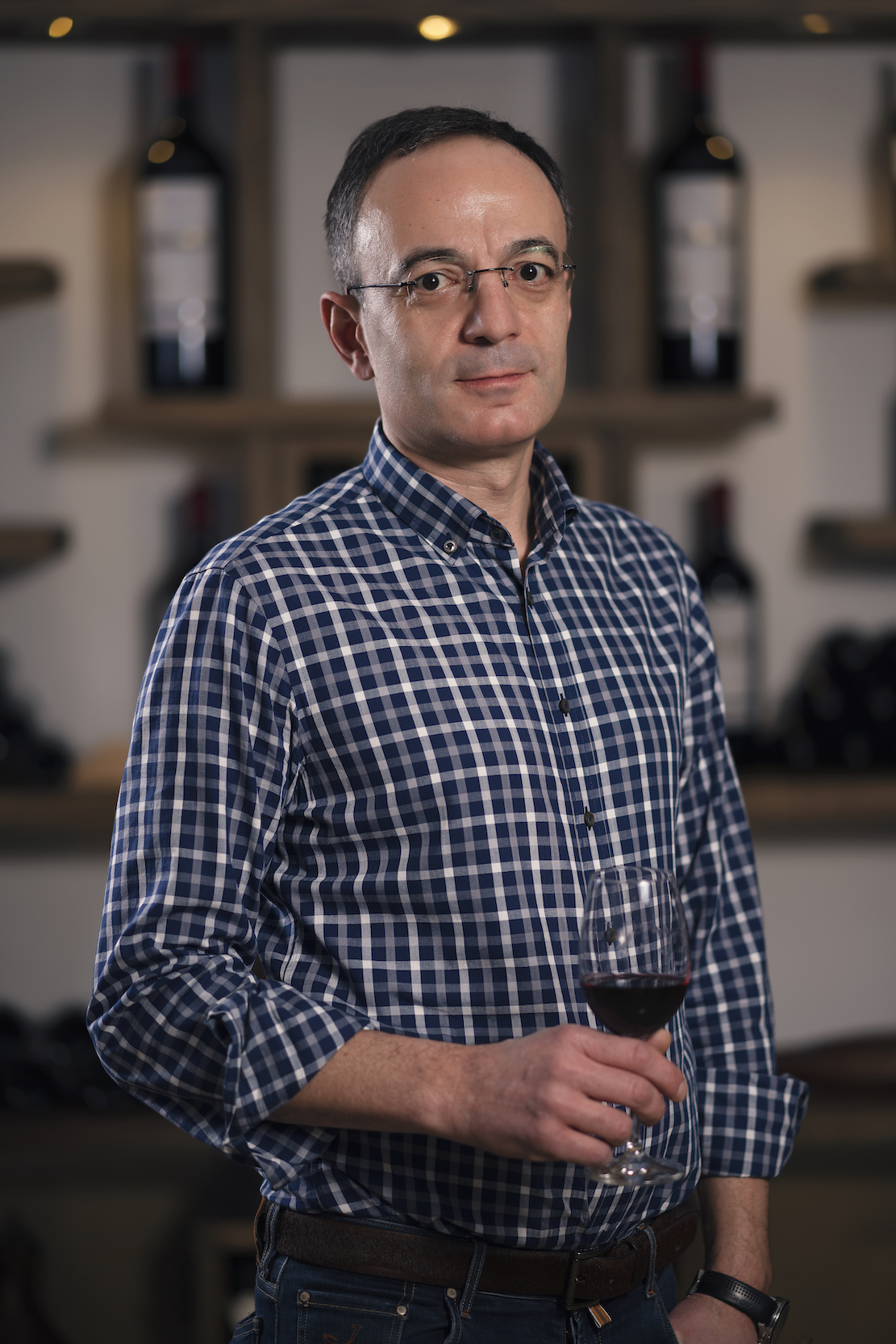
To gain perspective on
this rapidly growing industry, I spoke with
George Margvelashvili (left), who
hosted
the
10th International Organization for Vine and Wine
Congress, the same year
his Tbilvino’s first winery was opened in Tbilisi,
and a a second in 2008 in Kakheti,
the main wine region of Georgia; in 2014, then
with his brother
planted 405 hectares in Kakheti. Also,
I spoke with Joerg Matthies (right), owner
of the Mosmieri Winebar and Shop in Tbilisi. Their
comments
have been combined.
Georgian
viticulture
is ancient dating back to 5000 BC, and the Middle
Ages were its
so-called Golden Age of wine. Why? What grapes did
they use?
According
to scientists,
the first Neolithic grape seeds found in Georgia
(Kvemo Kartli) date back 8,000
years. From that time onwards, viticulture and
winemaking were continuously
carried out on the territory of Georgia. This
distinguishes our country from
others in the region. There is no era, without
archaeological, ethnographic,
historical or written material on Georgian
viticulture and winemaking from
Neolithic to the present day.
There
are probably many varieties that did reach nowadays,
of which we know neither
the name nor has ever seen anyone born in the 21-20
and 19th centuries.
However, all those varieties that are widespread
today have a rather long time
to come. From sources we know that such varieties as
Saperavi, Rkatsiteli,
Khikhvi, Mtsvivani, Tsolikouri, Alexandrouli, etc.
existed in the Middle Ages.
However, it's
very interesting to know
what characters did the grapes have before
phylloxera.
What
damage did the Soviets do to Georgia’s wine
industry? Quantity over quality?
The
Soviets had the
so-called 5-year plans that pushed quantity over
quality. They ignored all
those interesting ancient grapes and planted only
3-4 varieties that were most
resistant to diseases and yielded biggest
quantities. That is why Georgia now
has huge vineyards of Rkatsiteli and Saperavi and
few vineyards of other
varieties, though many interesting varieties like
Kisi and Khikivi were almost
lost. We are trying to rediscover forgotten grapes
and grow them in our
vineyards. We [Margvelashvili] have
currently 8 varieties that are grown in our
vineyards: Rkatsiteli, Saperavi,
Kisi, Kakhetian Mtsvane, Khikhvi, Aleksandrouli,
Mujuretuli, Kakhetian
Mtsvivani. We plan to add more varieties in future
because we see that they
yield beautiful results that are absolutely worth
the effort.
Gorbachev
wanted
to cut back on production as part of an
ate-alcohol campaign. How did
this affect the industry?
In
general, we feel like
any industry should be regulated by the market. It
does not do any good when
the government artificially and forcefully
interferes and tries to change the
flow of things governed by the market. This was true
for Gorbachev’s forceful attempts
at an anti-alcohol campaign, obviously it damaged
the industry mainly affecting
big state enterprises. However public and farmer
families kept practicing
viticulture and winemaking
At what point—the 1990s?—did the industry begin
to revive?
From
the mid 1990s the
industry started to show signs of new life and by
2000 began reviving when exports
to Russia were not yet banned, which happened in
2006. It was a difficult and
painful transition from a centrally planned economy
to a market economy but it
happened nevertheless. New, private wineries emerged
that started to make wines
and attempted to introduce them to the world. Closed
by the Iron Curtain
Georgians who had been making wine for at least 8000
years, had to learn modern
winemaking methods, as well as find our own foreign
markets Only after 2010 did
the industry really gain strength, owing to tourism
think that this learning
continues today. Since late 1990s we have worked
with foreign winemakers and
wine consultants from different countries such as
Australia, France, Italy to
finetune our technological process and get the best
out of Georgian grapes and
terroirs. Among the challenges remaining is the huge
dependence on the new Russian market
(58% in 2021) and the relatively low awareness on
western markets. We are the
only sizable winery in Georgia to have fully stopped
sales to Russia since the
start of the war in Ukraine. All of our efforts are
now focused on entering and
increasing our presence on western and Asian markets
(UK, USA, Germany, China,
South Korea, etc.).
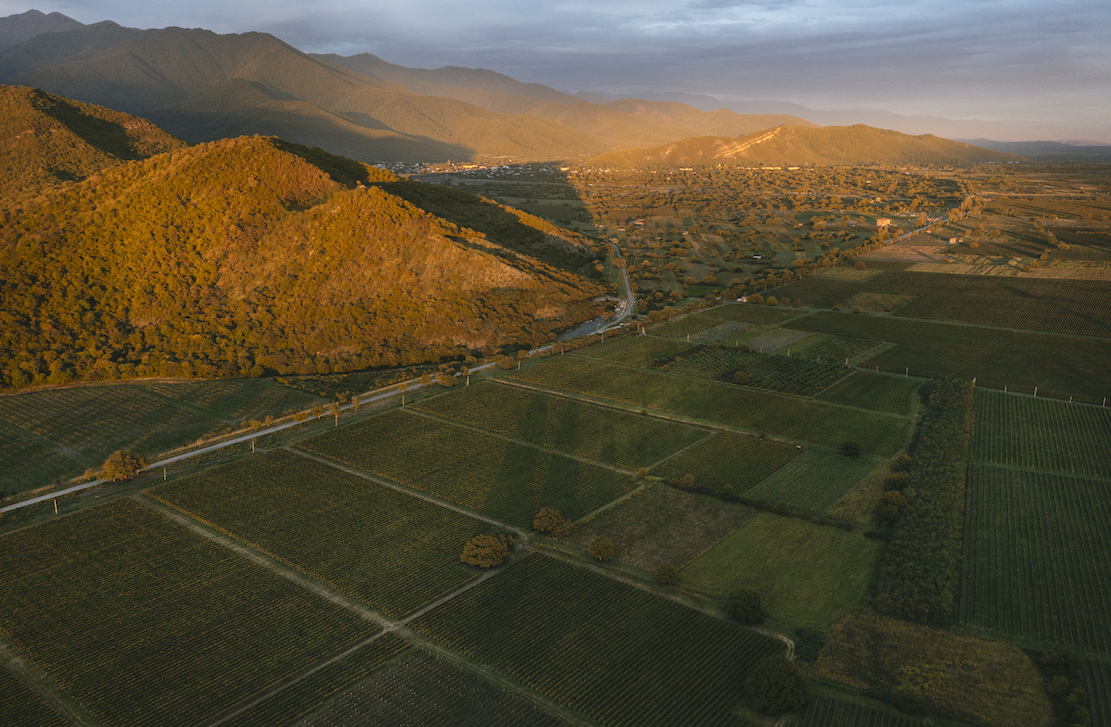 Am
I
correct that there are 10 recognized areas now?
Kakheti, Imereti, etc.
Am
I
correct that there are 10 recognized areas now?
Kakheti, Imereti, etc.
What you list are the
regions of Georgia (Kakheti, Kartli, Imereti, Guria,
Samegrelo, Afkhadzia,
Adjara, Racha, Lechkhumi, Meskheti-Javakheti). In
almost every region of
Georgia you have vineyards with different soil
composition, climate, grape
varieties and winemaking techniques. Throughout the
regions there are the
so-called PDOs (Protected Designations of Origin) or
micro zones that are
designated for this or that particular wine.
Currently there are 25 of them.
Our 405 hectares of vineyards are located in three
of leading Georgian PDOs
(all in Kakheti): Tsinandali (famous for white dry
wines), Mukuzani (famous for
red dry wines) and Kindzmarauli (famous for medium
sweet wines). The
biggest wine producing region is cut Kakheti in the
east which makes up 70% of
all production.
What are qvevri? Are they
it widely used?
Qvevri
is an egg-shaped
clay vessel with a pointed bottom where the wine is
made. The qvevri is buried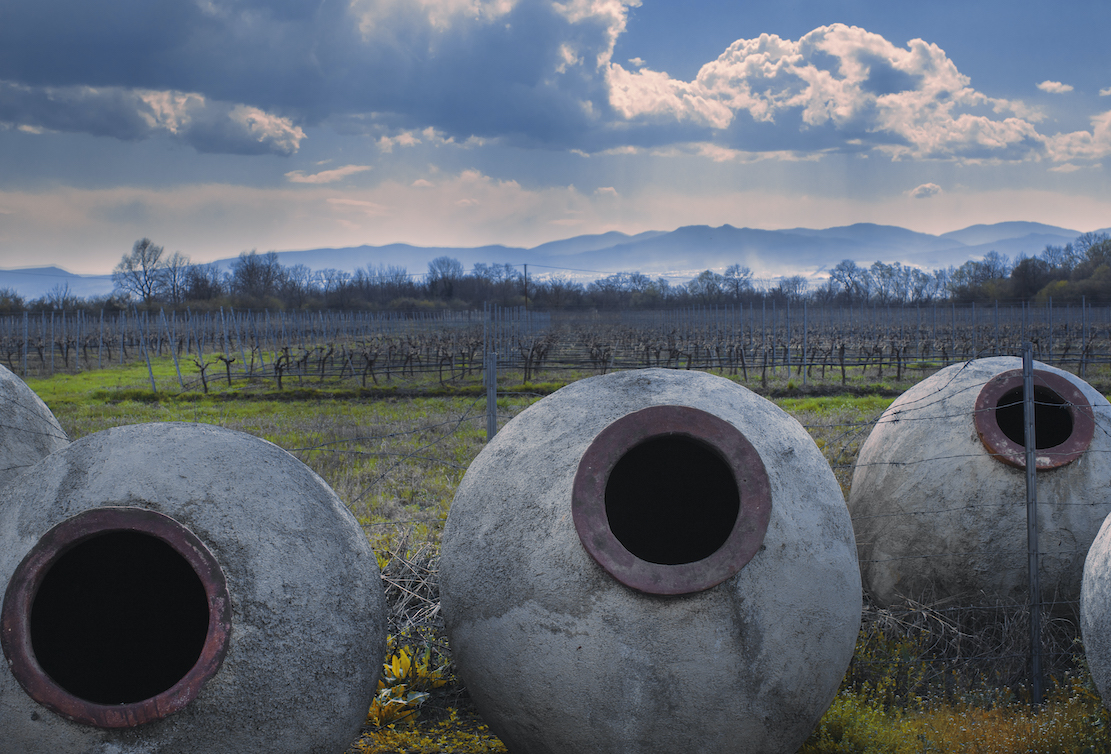 in the ground. Grape juice together with skins and
seeds is poured into the
qvevri where it is fermented and macerated for 5-6
months. During this time,
the wine is with skins thus greatly impacting the
wine, which acquires amber
color, structure and rich bouquet of aromas. Such
wines are becoming popular in
the world under the name of Amber wines. In 2013,
UNESCO recognized qvevri as
part of Intangible Cultural Heritage of Humanity.
What is important is that
qvevri has been alive throughout the history of
Georgian people and is still
very much alive today. This is a living tradition
counting 8000 years. Many
families around Georgia make wine for themselves in
qvevri. We started
producing qvevri wine in 2011. It was
just one wine and in very small quantities. Now we
produce five different wines
in qvevri. It is still a small part of our
production but is growing.
in the ground. Grape juice together with skins and
seeds is poured into the
qvevri where it is fermented and macerated for 5-6
months. During this time,
the wine is with skins thus greatly impacting the
wine, which acquires amber
color, structure and rich bouquet of aromas. Such
wines are becoming popular in
the world under the name of Amber wines. In 2013,
UNESCO recognized qvevri as
part of Intangible Cultural Heritage of Humanity.
What is important is that
qvevri has been alive throughout the history of
Georgian people and is still
very much alive today. This is a living tradition
counting 8000 years. Many
families around Georgia make wine for themselves in
qvevri. We started
producing qvevri wine in 2011. It was
just one wine and in very small quantities. Now we
produce five different wines
in qvevri. It is still a small part of our
production but is growing.
How
much wine is made
semi-sweet?
George
is
actually don’t drink semi sweet wines. These wines
such as Alazany valley,
Kindzmarauli or Khvanchkara became popular during
the Soviet union. Even today
Russia along with most other post-Soviet countries
in China are the most
important destinations for semi sweet wines.
At Château Mosby area we produce less than
10% semi-sweet or semi-dry
wines because dry wines are much more demand of the
premium sing.
At our
wineries [Margevelahvili] it is difficult to say
exactly but a lot. In our
portfolio the share of dry wines is increasing due
to the reason that the share
of western countries in our export geography is
widening. Plus, as I said
earlier, we had to exit the Russian market and
increase our focus on more
stable markets where dry wines are more appreciated.
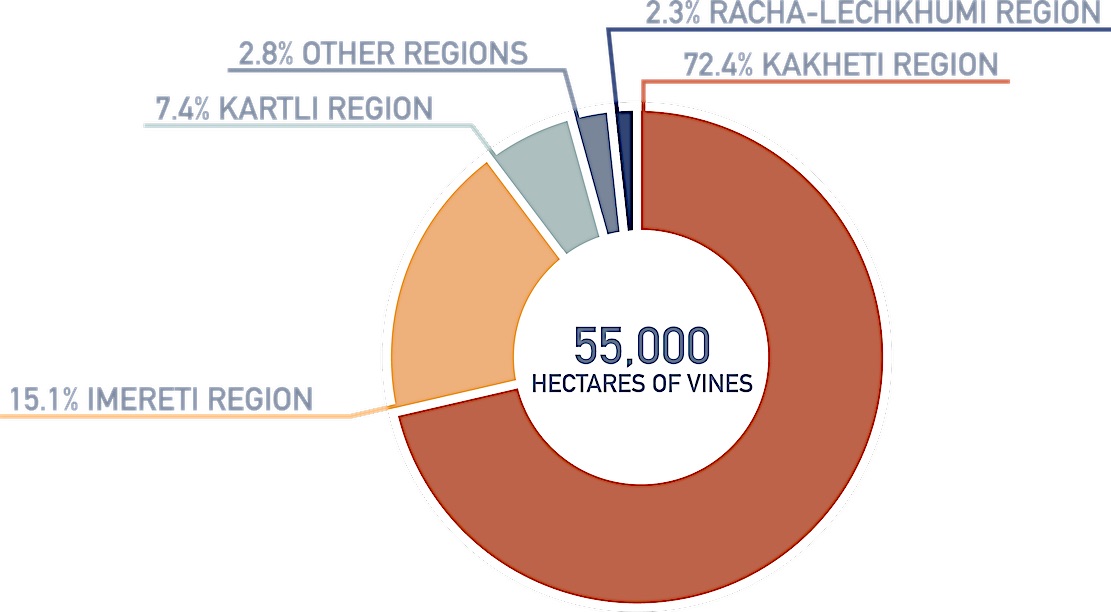 What is the current
production?
What is the current
production?
I can
say that wine production in Georgia is booming.
There are hundreds of wine
producers from tiny, one-man operations to family
wineries to big, large-scale
producers. Last year Georgian exported more that 90
million bottles, plus local
consumption. We managed to sell more than 5.5
million bottles in 30 different
countries. Chateau
Mosmieri they current
production capacity of 130,000 bottles per year made
from more than 21 ha
Where
are
Georgian wines exported?
The biggest export market for
Georgian wines was Russia
(58% of all Georgian wine exports in 2021 went
there). Other top markets
include Ukraine, Kazakhstan, Poland, China, Baltic
States, etc. We are working
a lot to increase presence and sales in other
markets such as the UK, USA,
Germany, South Korea, etc. It is a difficult
process, but we feel that being
successful on stable markets is the right way to
develop.
Has
climate change affected the vineyards?
Yes,
of course and that’s
why all our vineyards are equipped with drip
irrigation systems. Also harvest
shifted closer to summer and many other factors to
which our vineyards must be
adopted and our viticulturist team have to consider.
With
what other countries do Georgia’s prices compete?
Depending
on
the markets Georgian wines share shelves with
numerous other country wines
such as Spain, Italy, New World, etc. Georgian wines
cannot compete by price
because there are plenty of lower-priced wines on
the world market. Georgian
wines should compete with quality, uniqueness, and
history behind it. In
mass wine segments Georgia competes with countries
such as Moldova and other
Eastern European countries as well as low price
wineries from major wine
producing countries like Australia, Argentina, Chile
in South America
 THE HIGH ANXIETY THAT
PLAGUES AMERICA'S FOOD WRITERS!
THE HIGH ANXIETY THAT
PLAGUES AMERICA'S FOOD WRITERS!"Few dining
occasions feel as high stakes as your birthday
party. What if nobody comes? Is everyone happy with
the venue? Are the vibes correct? Are we having fun
yet? After working through the above concerns with
my therapist, I celebrated my July birthday at a
charming wine bar in Brooklyn."—Becky Hughes, "It's
Your Party and I'll Dine Out If You Want to." NY
Times (8/30/22)
.
❖❖❖
Any of John Mariani's books below may be ordered from amazon.com.
 The Hound in Heaven
(21st Century Lion Books) is a novella, and
for anyone who loves dogs, Christmas, romance,
inspiration, even the supernatural, I hope you'll find
this to be a treasured favorite. The story
concerns how, after a New England teacher, his wife and
their two daughters adopt a stray puppy found in their
barn in northern Maine, their lives seem full of promise.
But when tragedy strikes, their wonderful dog Lazarus and
the spirit of Christmas are the only things that may bring
his master back from the edge of despair.
The Hound in Heaven
(21st Century Lion Books) is a novella, and
for anyone who loves dogs, Christmas, romance,
inspiration, even the supernatural, I hope you'll find
this to be a treasured favorite. The story
concerns how, after a New England teacher, his wife and
their two daughters adopt a stray puppy found in their
barn in northern Maine, their lives seem full of promise.
But when tragedy strikes, their wonderful dog Lazarus and
the spirit of Christmas are the only things that may bring
his master back from the edge of despair. WATCH THE VIDEO!
“What a huge surprise turn this story took! I was completely stunned! I truly enjoyed this book and its message.” – Actress Ali MacGraw
“He had me at Page One. The amount of heart, human insight, soul searching, and deft literary strength that John Mariani pours into this airtight novella is vertigo-inducing. Perhaps ‘wow’ would be the best comment.” – James Dalessandro, author of Bohemian Heart and 1906.
“John Mariani’s Hound in Heaven starts with a well-painted portrayal of an American family, along with the requisite dog. A surprise event flips the action of the novel and captures us for a voyage leading to a hopeful and heart-warming message. A page turning, one sitting read, it’s the perfect antidote for the winter and promotion of holiday celebration.” – Ann Pearlman, author of The Christmas Cookie Club and A Gift for my Sister.
“John Mariani’s concise, achingly beautiful novella pulls a literary rabbit out of a hat – a mash-up of the cosmic and the intimate, the tragic and the heart-warming – a Christmas tale for all ages, and all faiths. Read it to your children, read it to yourself… but read it. Early and often. Highly recommended.” – Jay Bonansinga, New York Times bestselling author of Pinkerton’s War, The Sinking of The Eastland, and The Walking Dead: The Road To Woodbury.
“Amazing things happen when you open your heart to an animal. The Hound in Heaven delivers a powerful story of healing that is forged in the spiritual relationship between a man and his best friend. The book brings a message of hope that can enrich our images of family, love, and loss.” – Dr. Barbara Royal, author of The Royal Treatment.
 |
The Encyclopedia of American Food and Drink by John F. Mariani (Bloomsbury USA, $35) Modesty forbids me to praise my own new book, but let me proudly say that it is an extensive revision of the 4th edition that appeared more than a decade ago, before locavores, molecular cuisine, modernist cuisine, the Food Network and so much more, now included. Word origins have been completely updated, as have per capita consumption and production stats. Most important, for the first time since publication in the 1980s, the book includes more than 100 biographies of Americans who have changed the way we cook, eat and drink -- from Fannie Farmer and Julia Child to Robert Mondavi and Thomas Keller. "This book is amazing! It has entries for everything from `abalone' to `zwieback,' plus more than 500 recipes for classic American dishes and drinks."--Devra First, The Boston Globe. "Much needed in any kitchen library."--Bon Appetit. |
"Eating Italian will never be the same after reading John Mariani's entertaining and savory gastronomical history of the cuisine of Italy and how it won over appetites worldwide. . . . This book is such a tasteful narrative that it will literally make you hungry for Italian food and arouse your appetite for gastronomical history."--Don Oldenburg, USA Today. "Italian
restaurants--some good, some glitzy--far
outnumber their French rivals. Many of
these establishments are zestfully described
in How Italian Food Conquered the World, an
entertaining and fact-filled chronicle by
food-and-wine correspondent John F.
Mariani."--Aram Bakshian Jr., Wall Street
Journal.
"Equal parts
history, sociology, gastronomy, and just
plain fun, How Italian Food Conquered the
World tells the captivating and delicious
story of the (let's face it) everybody's
favorite cuisine with clarity, verve and
more than one surprise."--Colman Andrews,
editorial director of The Daily
Meal.com. "A fantastic and fascinating
read, covering everything from the influence
of Venice's spice trade to the impact of
Italian immigrants in America and the
evolution of alta cucina. This book will
serve as a terrific resource to anyone
interested in the real story of Italian
food."--Mary Ann Esposito, host of PBS-TV's
Ciao
Italia. "John Mariani has written the
definitive history of how Italians won their
way into our hearts, minds, and
stomachs. It's a story of pleasure over
pomp and taste over technique."--Danny Meyer,
owner of NYC restaurants Union Square
Cafe, The Modern, and Maialino.
|
 |
 |
 |
 |
 |
 |
 Everett Potter's Travel Report:
Everett Potter's Travel Report: 
 Eating Las
Vegas
Eating Las
Vegas
MARIANI'S VIRTUAL GOURMET
NEWSLETTER is published weekly. Publisher: John Mariani. Editor: Walter Bagley. Contributing Writers: Christopher
Mariani, Misha Mariani, John A. Curtas, Gerry Dawes, Geoff Kalish.
Contributing
Photographer: Galina Dargery. Technical
Advisor: Gerry
McLoughlin.
If you wish to subscribe to this
newsletter, please click here: http://www.johnmariani.com/subscribe/index.html
© copyright John Mariani 2022

